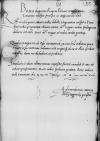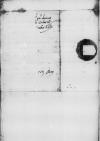Letter #1633
Bona Sforza to Ioannes DANTISCUSCracow (Kraków), 1537-04-26
| received [1537]-05-07 Manuscript sources:
| ||||
Text & apparatus & commentary Plain text Text & commentary Text & apparatus
[Reverendo in Christ]o Patri, domino [
Reverende in Christo Pater sincere nobis dilecte.
Unguentum missum a Paternitate Tua fuit nobis pergratum. Utinam autem
Simulacris dum ultima manus imposita fuerit, curabit Paternitas Tua, ut ad nos perferantur, rem nobis factura gratam.
Bene valeat.
Datae
Ad mandatum sacrae maiestatis reginalis proprium

